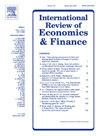碳价格动态与企业生产率:绿色创新与制度环境在中国碳排放交易机制中的作用
IF 5.6
2区 经济学
Q1 BUSINESS, FINANCE
引用次数: 0
摘要
碳排放配额的商品属性和金融属性在碳排放交易体系(CETS)中发挥着关键作用,碳价格直接反映了这些配额的潜在价值。本研究利用2010-2023年中国上市公司的数据,采用差异中的差异(DID)模型考察了碳价格水平和稳定性对全要素生产率(TFP)的影响。结果表明,碳价格水平和稳定性的提高都提高了全要素生产率,特别是在重污染企业和非国有企业中。机制分析表明,较高的价格和稳定性刺激企业参与绿色创新,触发波特效应,从而进一步提高全要素生产率。此外,优化系统环境是增强方案影响的有效手段。研究还发现,通过基于支付的机制分配初始配额提供了一种更有效的设计。研究结果强调了加强碳配额金融属性的重要性,并为促进交易活动和市场流动性提供了实际指导。本文章由计算机程序翻译,如有差异,请以英文原文为准。
Carbon price dynamics and firm productivity: The role of green innovation and institutional environment in China's emission trading scheme
The commodity and financial attributes of carbon emission allowances play a pivotal role within the Carbon Emission Trading Scheme (CETS), with carbon prices directly reflecting the underlying value of these allowances. This study employs a Difference-in-Differences (DID) model using data from publicly listed Chinese firms over 2010–2023 to examine the effects of carbon price levels and stability on total factor productivity (TFP). Results indicate that increases in both carbon price level and stability enhance TFP, particularly among heavy-polluting and non-state-owned enterprises. Mechanism analysis shows that higher prices and stability stimulate corporate engagement in green innovation, trigger the Porter effect, and thereby further improve TFP. Furthermore, optimizing the system environment proves to be an effective means of strengthening the scheme's impact. The study also finds that allocating initial quotas via payment-based mechanisms offers a more effective design. The findings underscore the importance of reinforcing the financial attributes of carbon allowances and provide practical guidance for boosting trading activity and market liquidity.
求助全文
通过发布文献求助,成功后即可免费获取论文全文。
去求助
来源期刊
CiteScore
7.30
自引率
2.20%
发文量
253
期刊介绍:
The International Review of Economics & Finance (IREF) is a scholarly journal devoted to the publication of high quality theoretical and empirical articles in all areas of international economics, macroeconomics and financial economics. Contributions that facilitate the communications between the real and the financial sectors of the economy are of particular interest.

 求助内容:
求助内容: 应助结果提醒方式:
应助结果提醒方式:


